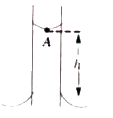Two soap bubbles A and B are given. Radius of B is 50% more than radius of A. Soap content (volume) of B as compared to A isSolution in Telugu
1.5
2.25
3.375
4
The correct Answer is:C
Step by step video, text & image solution for Two soap bubbles A and B are given. Radius of B is 50% more than radius of A. Soap content (volume) of B as compared to A is by Physics experts to help you in doubts & scoring excellent marks in Class 11 exams.
Updated on:21/07/2023Topper's Solved these Questions
- SURFACE TENSIONBOOK - AAKASH SERIESCHAPTER - SURFACE TENSIONEXERCISE - ADDITIONAL PRACTICE EXERCISE ( LEVEL-II LECTURE SHEET (ADVANCED)STRAIGHT OBJECTIVE TYPE QUESTIONS )
4 Videos
- SURFACE TENSIONBOOK - AAKASH SERIESCHAPTER - SURFACE TENSIONEXERCISE - ADDITIONAL PRACTICE EXERCISE ( LEVEL-II LECTURE SHEET (ADVANCED) LINKED COMPREHENSION TYPE QUESTIONS)
2 Videos
- SURFACE TENSIONBOOK - AAKASH SERIESCHAPTER - SURFACE TENSIONEXERCISE - PRACTICE SHEET ( EXERCISE-III Miscellaneous LEVEL - II LINKED COMPREHENSION TYPE QUESTIONS)
6 Videos
- SIMPLE HARMONIC MOTION BOOK - AAKASH SERIESCHAPTER - SIMPLE HARMONIC MOTION EXERCISE - ADDITIONAL PRACTICE EXERCISE (LEVEL - II)(PRACTICE SHEET (ADVANCED)) (INTEGER TYPE QUESTIONS)
3 Videos
- SYSTEM OF PARTICLES AND ROTATIONAL MOTIONBOOK - AAKASH SERIESCHAPTER - SYSTEM OF PARTICLES AND ROTATIONAL MOTIONEXERCISE - PRACTICE EXERCISE
99 Videos
Similar Questions
When a drop splits up into a number of drops
View SolutionThe property of surface tension tends to persists even if a liquid is solidified. Hence, solids can also be assumed to possess surface tension. Consider a liquid in contact with a solid with air above. Let T1,T2 and T3 be the surface tension at the liquid-air interface, solid-air interface and the solid-liquid interface.

The liquid drop will spreads on the solid surface if
View SolutionThe figure shows a capillary tube of radius r dipped into water. The atmospheric pressure is p0 and the capillary rise of water is h. the surface tension for water-glass is s

The pressure inside water at the point A (lowest point of the ineniscus) is
View SolutionConsider the motion of a ball in a tunnel through the earth (radius of the earth is R and mass of the earth is M), the tunnel is along a chord and the ball is released from the surface. The time period of the ball is √x (approx), find x.
View SolutionThe centre of mass of two particles with masses 2kg and 6 kg located at (1,1,1), (2,2,1) respectively has the coordinates
View SolutionTwo soap bubbles of radii a and b coalesce to form a single bubble of radius c . If the external pressure is P , find the surface tension of the soap solution.
View SolutionA soap bubble is given a negative charge, then its radius
View SolutionTwo spherical soap bubbles of radii a and b in vacuum coalesce under isothermal conditions. The resulting bubble has a radius given by
View SolutionA spherical soap bubble A of radius 2 cm is formed inside another bubble B of radius 4 cm. Show that the radius of a single soap bubble which maintance the same pressure difference as inside the smaller and outside the larger soap bubble is lesser than radius of both soap bubbles A and B.
View SolutionTwo soaps A and B are given. Dimensions of B are 50% more each than dimension of A. Soap content of B as compared to A is
View SolutionA spherical soap bubble A of radius 2 cm is formed inside another bubble B of radius 4 cm. Show that the radius of a single soap bubble which maintains the same pressure difference as inside the smaller and outside the larger soap bubble is lessser than radius of both bubbles A and B.
View SolutionA spherical soap bubble A of radius 2 cm is formed inside another bubble B of radius 4 cm. Show that the radius of a single soap bubble which maintance the same pressure difference as inside the smaller and outside the larger soap bubble is lesser than radius of both soap bubbles A and B.
View SolutionTwo spherical soap bubbles of radii a and b in vacuum coalesce under isothermal condition. The resulting bubbles has a radius given by …..
View SolutionTwo spherical soap bubbles of radii a and b in vacuum coalesce under isothermal conditions. The resulting bubbles has a radius given by
View SolutionSpherical soap bubbles of radius a and radius b are added to the vacuum. Then the radius of the bubble thus formed will be
View Solution
